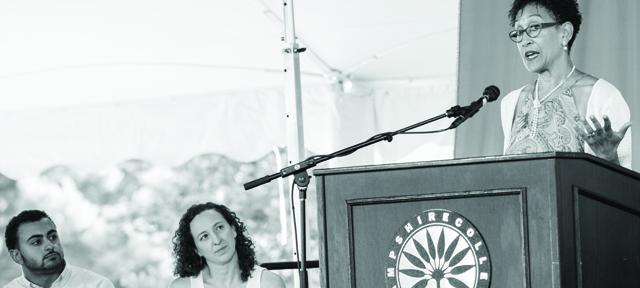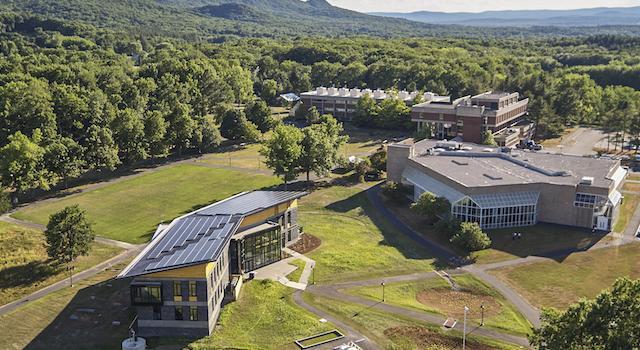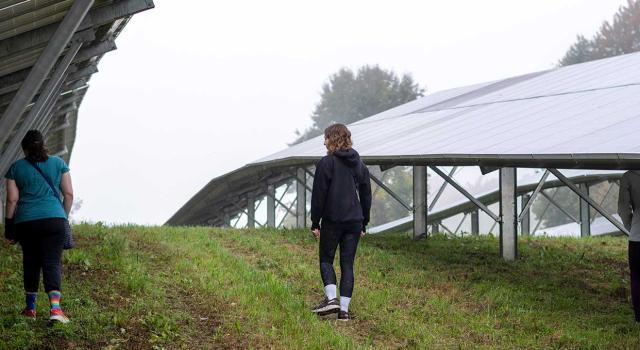Environmentalism and Environmental Justice

Part Two of Three Selections of Speeches From The Kern Center Dedication on September 16
“Love as Critical Inquiry”
by Dayna Cunningham
Every black mother I know struggles to find the school that will understand their children and know them to be the learners and the voracious seekers that they actually are. Terms like “achievement gap” describe the sense of insufficiency that attaches to them at the earliest ages. At ten my perceptive son asked, “Why do they think black children can’t learn?” Hampshire was the first institution to see my child for what he was. My love of Hampshire begins with that.
My son was bored with school. He was seriously considering not going to college, but he humored me and went on a college tour. Our first visit took us to this windowless basement where they showed us row upon row of dusty senior theses and said, “This is the intellectual engagement of our students.” It didn’t help my case at all. But when we got to Hampshire we could immediately feel the immersive learning environment. We saw excited and serious students engaged in urgent hands-on learning and compelling intellectual projects. There was the young woman sitting outside under a tree with a microphone, recording squirrel chirps and mapping them to the pentatonic scale.
I still remember that. There was a student who was in Mongolia living with horsemen, studying horse-tackle. We were in the Red Barn, listening to a presentation, and they talked about how many students at Hampshire go on to get a PhD.
In that moment my son turned to me and said, I can see myself here.
I can see myself here. The question for me was, “Could Hampshire see him?” Well, it did.
My son took a film theory class and didn’t like it. The professor said, “Well, then, take this camera and go make something. See me when you’ve got something to show.” Nobody here, nobody, didn’t think he couldn’t learn.
We didn’t hear from him until Thanksgiving. He came home on break and brought ten young men with him, almost all men of color. They sat around my kitchen and debated policy, morals, ethics. My son, the nihilist, was becoming a citizen! At the end of the first semester we got a letter from Jonathan Lash, sent to all the freshman parents. It said, “Because Hampshire’s selection process was becoming more rigorous, because it was becoming more rigorous, the number of students of color was increasing.” Not in spite of, but because there was more rigor.
I had been waiting for a letter like that for eighteen years. I am here to tell you I am a witness that Hampshire — because it enables and honors the broadest kinds of learning styles, because it insists that the purpose of knowing is to change the world, and because it cultivates responsible citizens — has room for my black son and for many, many others. To my mind, that’s the highest purpose of an educational institution. I’m a huge fan of John Dewey and his idea about citizen scientists: learning about democracy by putting their hands around urgent problems. This of course is Hampshire. In my day job I run a planning laboratory in the Department of Urban Studies at MIT. Our concept is “innovation from the margins,” that people who have suffered, who have faced institutional failure, actually have important ideas about how to reinvent institutions.
We spent years, for example, working with women trash- pickers who live in dumps in isolated islands in Central America. They were building businesses to recycle, and in the process taking up a huge global challenge, getting trash out of the oceans. These illiterate, overlooked, isolated, brilliant women were taking on a major global challenge. For the world. This is innovation from the margins. It’s also an intriguing way to think about environmental justice.
John Dewey also believed that the true source of democracy was a widespread tendency among the citizenry toward empathy. Here in our little corner of the world, the Kern Center embodies this idea of this waste-pickers’ spirit of all hands on deck, ecological innovation, and environmental justice. It embodies the cultivation of widespread empathy. Every laminated beam, every super-efficient pane of glass, every coat of nontoxic varnish is actually a love note to our sweet endangered earth and an invitation to us as citizen scientists to learn how to take care of her. So, I say that the Kern Center is using love as a method of analysis, as a form of critical inquiry, as a way to help us grasp how to extend ourselves for the well-being of others. Simply put, the Kern is another reminder that to know is not enough. Non satis scire. And, of course, that is pure Hampshire. It’s what we do at Hampshire. It’s what brought my son to Hampshire. It’s what I love about Hampshire. I suspect it’s why most of you are here. It is truly an honor to share this day with you.
Dayna Cunningham P12 is the executive director of the MIT Community Innovators Lab (CoLab) and a Hampshire parent and trustee. An attorney, she’s worked throughout her career to promote democratic participation and address social marginality.
"Seven Petals and Four Principles"
by Jonathan Lash
I think we can consider the R.W. Kern Center dedicated! Thank you all. And Dante, we would have built the building just to hear you deliver those words.
The Living Building Challenge is based on seven petals: place, water, energy, health and happiness, materials, equity, and beauty. They drive the design and construction process. But we’re a mission-driven institution that encourages students to fi learning and experience inside and outside the classroom. So for us, I suggest there are four additional principles. Buildings that are built at an institution like ours should teach, should speak of institutional values, and should enable community. They should also add to the overall sustainability of the campus because the entire campus is a teaching tool. I hope you’ll agree from what we’ve heard this morning that this building does all those things. We hope it speaks loudly. We’ve already had hundreds of visitors — from colleges and universities, architecture and building fi and even GE, which is exploring ideas for its new headquarters in Boston. We want this building to speak to you, too. Imagine a world in which most buildings live the way the R.W. Kern Center does. How many workers who manufacture or install materials would be healthier? How many people who work inside of a structure like this would feel better and be happier? How much would we reduce CO2 emissions, waste treatment, and water use? I leave you with two questions today: Why can’t all buildings be like this one? And how do we make it happen?
Jonathan Lash is president of Hampshire College.
From the Fall 2016 issue of Hampshire's Non Satis Scire magazine.



